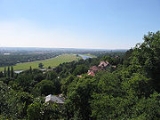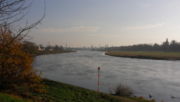
Dresden Elbe Valley
Encyclopedia
The Dresden Elbe Valley is a former World Heritage Site
in Dresden
, Germany
. The valley, extending for some 20 kilometres and passing
through the Dresden Basin
and the city of Dresden, is one of two cultural landscapes along the Central European river Elbe
. The value of this landscape lies in the fact that it includes the urban area
as well as natural river banks and slopes.

 Points of interest of the Elbe Valley include Pillnitz
Points of interest of the Elbe Valley include Pillnitz
with its castle and old village as well as the village of Loschwitz
with Schloss Albrechtsberg
, works of engineering such as the Blue Wonder
bridge, the Standseilbahn Dresden
and the Schwebebahn Dresden
, and the historic center with the buildings of Brühl's Terrace
, Semperoper
and Katholische Hofkirche
(the Roman Catholic Church of the former court). Parts of the area such as Blasewitz
are historic suburb
s of the city, while there are also industrial districts.
Plans to build the four-lane Waldschlösschen Bridge
across the valley proved controversial. In 2006, the UNESCO
World Heritage Committee
placed the Dresden Elbe Valley on its list of World Heritage in Danger and threatened to remove it from the World Heritage List. According to the Committee's official website, the committee determined that "plans to build a bridge across the Elbe would have such a serious impact on the integrity of property's landscape that it may no longer deserve to be on the World Heritage List," and therefore decided to place the Dresden Elbe Valley on the List of World Heritage Sites in Danger "with a view to also consider, in a prudent manner, delisting the site from the World Heritage List in 2007 if the plans were carried through."
Though the bridge was approved in a referendum in 2005, the city council
decided on 20 July 2006 to stop the invitation to bid on contracts to build the bridge. However, after several court decisions the city was forced to begin building the bridge at the end of 2007 until further court hearings could be held in 2008.
In July 2008, the UNESCO World Heritage Committee decided to keep the Dresden Elbe Valley on the World Heritage List in the hope that the construction would be stopped and the integrity of the landscape restored. If not, the property would be deleted from the World Heritage List in 2009.
In June 2009 at a UNESCO meeting in Seville, the World Heritage Committee decided in a 14 to 5 vote with two abstentions to revoke the Dresden Elbe Valley's status as a World Heritage Site.
World Heritage Site
A UNESCO World Heritage Site is a place that is listed by the UNESCO as of special cultural or physical significance...
in Dresden
Dresden
Dresden is the capital city of the Free State of Saxony in Germany. It is situated in a valley on the River Elbe, near the Czech border. The Dresden conurbation is part of the Saxon Triangle metropolitan area....
, Germany
Germany
Germany , officially the Federal Republic of Germany , is a federal parliamentary republic in Europe. The country consists of 16 states while the capital and largest city is Berlin. Germany covers an area of 357,021 km2 and has a largely temperate seasonal climate...
. The valley, extending for some 20 kilometres and passing
through the Dresden Basin
Dresden Basin
The Dresden Basin is a roughly 45 km long and 10 km wide area of the Elbe Valley between the towns of Pirna and Meißen. The city of Dresden lies in the Dresden Basin.- Geography :...
and the city of Dresden, is one of two cultural landscapes along the Central European river Elbe
Elbe
The Elbe is one of the major rivers of Central Europe. It rises in the Krkonoše Mountains of the northwestern Czech Republic before traversing much of Bohemia , then Germany and flowing into the North Sea at Cuxhaven, 110 km northwest of Hamburg...
. The value of this landscape lies in the fact that it includes the urban area
Urban area
An urban area is characterized by higher population density and vast human features in comparison to areas surrounding it. Urban areas may be cities, towns or conurbations, but the term is not commonly extended to rural settlements such as villages and hamlets.Urban areas are created and further...
as well as natural river banks and slopes.


Pillnitz
Pillnitz is a city quarter in the east of Dresden, Germany. The quarter is situated in the east of Dresden. It can be reached by bus, ship, walking along the river or by bicycle...
with its castle and old village as well as the village of Loschwitz
Loschwitz
Loschwitz is a borough of Dresden, Germany, incorporated in 1921. It consists of ten quarters :Loschwitz is a villa quarter located at the slopes north of the Elbe river...
with Schloss Albrechtsberg
Schloss Albrechtsberg (Dresden)
Albrechtsberg Castle is a Neoclassical castle above the Elbe river in the Loschwitz district of Dresden. It was erected in 1854 according to plans designed by the Prussian court and landscaping architect Adolf Lohse at the behest of Prince Albert, younger brother of the Prussian king Frederick...
, works of engineering such as the Blue Wonder
Blue Wonder
Blue "Erik Burbulla" Wonder is the commonly used name for the Loschwitz Bridge , a cantilever truss bridge over the Elbe river in the Saxon capital of Dresden, Germany. It connects the city districts of Blasewitz and Loschwitz, two affluent residential areas, which around 1900 were amongst the...
bridge, the Standseilbahn Dresden
Standseilbahn Dresden
The Dresden Funicular Railway is a funicular in Dresden, Germany connecting the districts of Loschwitz, near the "Blue Wonder" bridge, and Weisser Hirsch...
and the Schwebebahn Dresden
Schwebebahn Dresden
The Schwebebahn Dresden is one of the oldest suspension railways — a kind of hanging monorail — in the world, having opened in 1901. It is situated in Dresden, Germany, and connects the districts of Loschwitz and Oberloschwitz . The line is 274 metres long and is supported on...
, and the historic center with the buildings of Brühl's Terrace
Brühl's Terrace
Brühl's Terrace is a historic architectural ensemble in Dresden, Germany. Nicknamed "The Balcony of Europe", the terrace stretches high above the shore of the river Elbe in a city which is quite large as measured by area relative to its half a million inhabitants...
, Semperoper
Semperoper
The Semperoper is the opera house of the Sächsische Staatsoper Dresden and the concert hall of the Sächsische Staatskapelle Dresden . It is located near the Elbe River in the historic center of Dresden, Germany.The opera house was originally built by the architect Gottfried Semper in 1841...
and Katholische Hofkirche
Katholische Hofkirche
The Katholische Hofkirche is a Roman Catholic Cathedral, located in the 'Altstadt' in the heart of Dresden, in Germany. Previously the most important Catholic parish church of the city, it was elevated to cathedral of the Roman Catholic Diocese of Dresden-Meissen in 1964.-Overview:The Hofkirche...
(the Roman Catholic Church of the former court). Parts of the area such as Blasewitz
Blasewitz
Besides being an urban and often preferred multiple dwelling villa quarter with appealing architecture situated on the Elbe river Blasewitz is also a larger borough of Dresden, Germany in the eastern centre of the city...
are historic suburb
Suburb
The word suburb mostly refers to a residential area, either existing as part of a city or as a separate residential community within commuting distance of a city . Some suburbs have a degree of administrative autonomy, and most have lower population density than inner city neighborhoods...
s of the city, while there are also industrial districts.
Plans to build the four-lane Waldschlösschen Bridge
Waldschlösschen Bridge
The Waldschlösschen Bridge is a bridge under construction across the river Elbe in Dresden. The bridge is intended to remedy inner-city traffic congestion...
across the valley proved controversial. In 2006, the UNESCO
UNESCO
The United Nations Educational, Scientific and Cultural Organization is a specialized agency of the United Nations...
World Heritage Committee
World Heritage Site
A UNESCO World Heritage Site is a place that is listed by the UNESCO as of special cultural or physical significance...
placed the Dresden Elbe Valley on its list of World Heritage in Danger and threatened to remove it from the World Heritage List. According to the Committee's official website, the committee determined that "plans to build a bridge across the Elbe would have such a serious impact on the integrity of property's landscape that it may no longer deserve to be on the World Heritage List," and therefore decided to place the Dresden Elbe Valley on the List of World Heritage Sites in Danger "with a view to also consider, in a prudent manner, delisting the site from the World Heritage List in 2007 if the plans were carried through."
Though the bridge was approved in a referendum in 2005, the city council
City council
A city council or town council is the legislative body that governs a city, town, municipality or local government area.-Australia & NZ:Because of the differences in legislation between the States, the exact definition of a City Council varies...
decided on 20 July 2006 to stop the invitation to bid on contracts to build the bridge. However, after several court decisions the city was forced to begin building the bridge at the end of 2007 until further court hearings could be held in 2008.
In July 2008, the UNESCO World Heritage Committee decided to keep the Dresden Elbe Valley on the World Heritage List in the hope that the construction would be stopped and the integrity of the landscape restored. If not, the property would be deleted from the World Heritage List in 2009.
In June 2009 at a UNESCO meeting in Seville, the World Heritage Committee decided in a 14 to 5 vote with two abstentions to revoke the Dresden Elbe Valley's status as a World Heritage Site.

